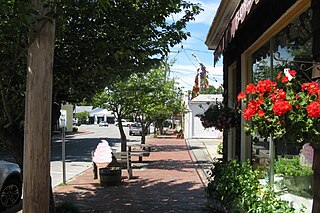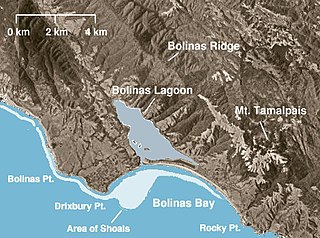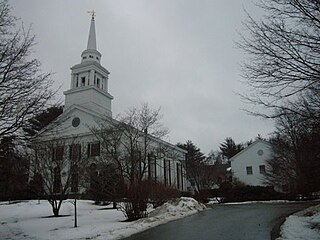
John Alden was a crew member on the historic 1620 voyage of the Mayflower which brought the English settlers commonly known as Pilgrims to Plymouth Colony in present-day Massachusetts, US. He was hired in Southampton, England, as the ship's cooper, responsible for maintaining the ship's barrels. Although he was a member of the ship's crew and not a settler, Alden decided to remain in Plymouth Colony when the Mayflower returned to England. He was a signatory to the Mayflower Compact.

Myles Standish was an English military officer and colonist. He was hired as military adviser for Plymouth Colony in present-day Massachusetts, United States by the Pilgrims. Standish accompanied the Pilgrims on the ship Mayflower and played a leading role in the administration and defense of Plymouth Colony from its foundation in 1620. On February 17, 1621, the Plymouth Colony militia elected him as its first commander and continued to re-elect him to that position for the remainder of his life. Standish served at various times as an agent of Plymouth Colony on a return trip to England, as assistant governor of the colony, and as its treasurer.

South Duxbury is a census-designated place (CDP) in the town of Duxbury in Plymouth County, Massachusetts, United States. The population was 3,360 at the 2010 census.

Duxbury is a historic seaside town in Plymouth County, Massachusetts, United States. A suburb located on the South Shore approximately 35 miles (56 km) to the southeast of Boston, the population was 16,090 at the 2020 census.

Priscilla Alden was a noted member of Massachusetts's Plymouth Colony of Pilgrims and the wife of fellow colonist John Alden. They married in 1621 in Plymouth.

Duxbury Beach is a barrier beach in the town of Duxbury, Massachusetts. It is six miles long and is accessed by the Powder Point Bridge from Duxbury, or Gurnet Road from Marshfield. Since 1975, approximately 4.5 miles of the beach is owned by Duxbury Beach Reservation, Inc, which annually leases a substantial portion of the beach—excepting the Duxbury Beach Park area—to the town of Duxbury. Under this arrangement, the town issues beach vehicle permits, provides police protection, and provides conservation officers to patrol the beach in all seasons of the year.
Plymouth Harbor is a harbor located in Plymouth, a town in the South Shore region of the U.S. state of Massachusetts. It is part of the larger Plymouth Bay. Historically, Plymouth Harbor was the site of anchorage of the Mayflower where the Plymouth Colony pilgrims disembarked in 1620 to establish a permanent settlement at Plymouth.

Plymouth Bay is a small, well-protected bay of the Atlantic Ocean on the western shore of larger Cape Cod Bay along the coastline of the Commonwealth of Massachusetts. Plymouth Bay retains historical significance for the landing at Plymouth Rock in 1620 by the Pilgrims aboard the Mayflower who proceeded to establish the first permanent Northern European settlement in North America at Plymouth Colony.

Clark's Island is the name of a small island located in Duxbury Bay in the U.S. state of Massachusetts. It was named for John Clark, the first mate of the Mayflower, the ship that brought the Pilgrims to New England. The island was initially considered for the location of the Pilgrim's settlement, but was rejected in favor of a site to the south, which became known as Plymouth, Massachusetts. Today Clark's Island is a part of the town of Plymouth.

Gurnet Point, also known as The Gurnet, is located at the end of the peninsula at the entrance to Plymouth Bay in Plymouth, Massachusetts, and is a headland and the small private settlement located on it. The Pilgrims who settled Plymouth in 1620 named it Gurnett's Nose for its resemblance to headlands in the English Channel where gurnett fish were plentiful. The Gurnet is the home of Plymouth (Gurnet) Lighthouse as well as Fort Andrew from the Revolutionary War and Civil War. Its access by land is either from Gurnet Road in Duxbury or from the Powder Point Bridge at Duxbury Beach 5 miles to the north by foot or by 4-wheel drive beach buggies, but access is restricted to property owners, residents and their guests, except for once a year on Memorial Day when the lighthouse is open to the public.
Duxbury Bay is a bay on the coast of Massachusetts in the United States. The west shore of the bay is the town of Duxbury, Massachusetts; and the bay is formed by a sandbar called The Gurnet extending southeasterly from Marshfield, Massachusetts into Cape Cod Bay. The town of Marshfield was named for the estuarine wetland at the north end of the bay. The bay opens southerly toward Plymouth, Massachusetts between Captains Hill to the west and Saquish Head to the east.

The Myles Standish Burial Ground in Duxbury, Massachusetts is, according to the American Cemetery Association, the oldest maintained cemetery in the United States.

First Parish Church in Plymouth is a historic Unitarian Universalist church at the base of Burial Hill on the town square off Leyden Street in Plymouth, Massachusetts. The congregation was founded in 1620 by the Pilgrims in Plymouth. The current building was constructed in 1899.

Duxbury Reef State Marine Conservation Area (SMCA) is a marine protected area located about 1 mile (2 km) west of Bolinas in Marin County on California’s north central coast. This marine protected area covers 0.66 square miles (1.7 km2). Duxbury Reef SMCA prohibits the take of all living marine resources, except the recreational take of finfish from shore only and the recreational take of abalone.

Leyden Street, is a street in Plymouth, Massachusetts that was created in 1620 by the Pilgrims, and claims to be the oldest continuously inhabited street in the Thirteen Colonies of British North America.
Elder Love Brewster was an early American settler, the son of Elder William Brewster and his wife, Mary Brewster. He traveled with his father, mother and brother, Wrestling, on the Mayflower reaching what became the Plymouth Colony in Massachusetts in 1620. Brewster had two sisters, Patience and Fear, and two brothers, Jonathan and Wrestling, along with an unnamed sister who died young. He was a founder of the town of Bridgewater, Plymouth County, Massachusetts.

Capt. Jonathan Alden Sr., the son of Mayflower immigrants, was a military officer and farm owner in Plymouth Colony. The home he built in the late 1600s is now a National Historic Landmark in Duxbury, Massachusetts.

The Bluefish River is a stream in Duxbury, Massachusetts ending in a tidal river estuary that was the center of an active shipbuilding industry during the early 19th century. Its source is a set of small ponds located near the intersection of Partridge Road and Washington Street, about one-third of a mile from Hall's Corner in Duxbury. The river is fed by Hounds Ditch Brook which empties into the Bluefish at the tidal estuary. The river contains Duxbury’s second anadromous fish run, with a privately-owned fish ladder south of Harrison Street. A large portion of the northern shore of the Bluefish River estuary is occupied by the Capt. David Cushman Preserve operated by the Wildlands Trust which contains walking trails with views of the estuary. Near its mouth, the river passes under the stone Bluefish River Bridge, a local landmark and part of the Old Shipbuilders Historic District. The river discharges into Duxbury Bay between Long Point and Bumpus Park.

The Old Town Hall Historic District is a historic district on Tremont Street in Duxbury, Massachusetts. The district includes the town's Greek Revival town hall, the Greek Revival First Parish Church, and the 18th-century Mayflower Cemetery. The district was added to the National Register of Historic Places in 2021 for its architecture and local historical significance.














